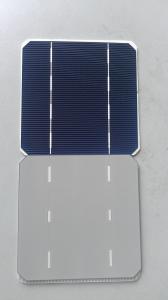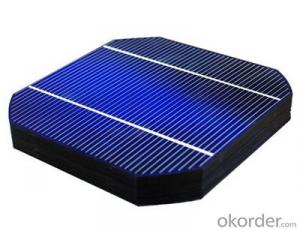Third Generation Solar Cells - Mono Solar Cell 125mm x 125mm x 0.5mm
- Loading Port:
- China main port
- Payment Terms:
- TT or LC
- Min Order Qty:
- 40000 watt
- Supply Capability:
- 100000 watt/month
OKorder Service Pledge
OKorder Financial Service
You Might Also Like
Details Of Mono Solar Cell 125mm
Specifications Of Mono Solar Cell 125mm
1.Mechanical data and design
Format | 125 mm × 125 mm ± 0.5 mm |
Thickness | 210 μm ± 40 μm |
Front(-) | 1.6 mm bus bars (silver),blue anti-reflection coating (silicon nitride) |
Back (+) | 2.5 mm wide soldering pads (silver) back surface field (aluminium) |
2.Temperature Coefficient of Cells
Voc. Temp . coef.%/K | -0.35%/K |
Isc . Temp . coef.%/K | +0.024%/K |
Pm. Temp. coef.%/K | -0.47%/K |
3.Electrical Characteristic
Efficiency(%) | Pmpp (W) | Umpp (V) | Impp (A) | Uoc (V) | Isc (A) | FF (%) |
18.35 | 2.841 | 0.532 | 5.342 | 0.631 | 5.67 | 79.41% |
18.20 | 2.817 | 0.53 | 5.319 | 0.631 | 5.64 | 79.16% |
18.05 | 2.794 | 0.527 | 5.301 | 0.63 | 5.63 | 78.77% |
17.90 | 2.771 | 0.527 | 5.259 | 0.629 | 5.62 | 78.39% |
17.75 | 2.748 | 0.526 | 5.224 | 0.629 | 5.61 | 77.88% |
17.60 | 2.725 | 0.524 | 5.201 | 0.629 | 5.59 | 77.50% |
17.45 | 2.702 | 0.52 | 5.196 | 0.629 | 5.586 | 76.90% |
17.30 | 2.678 | 0.516 | 5.183 | 0.626 | 5.577 | 76.71% |
17.15 | 2.655 | 0.513 | 5.175 | 0.623 | 5.565 | 76.58% |
17.00 | 2.632 | 0.51 | 5.161 | 0.622 | 5.559 | 76.12% |
16.75 | 2.593 | 0.508 | 5.103 | 0.615 | 5.477 | 76.98% |
16.50 | 2.555 | 0.506 | 5.047 | 0.608 | 5.396 | 77.88% |
4.Intensity Dependence
Advantage Of Mono Solar Cell 125mm
1: high quality cell, Level A cell (16.50%—18.35%)
2: Dimensione:125*125mm Diagonal:150mm / 165mm
Dimensione:156*156mm Diagonal:200mm
3: Qualified certification: TUV,CE certification.
4: Warranty: five years for whole unit
Usage/Application Of Mono Solar Cell 125mm
Packaging & Delivery Of Mono Solar Cell 125mm | |
Packaging Detai | Packaging Detail:Export Carton and Pallet or under customer request. |
Delivery Detail:10-20days | |


Converting the sun’s radiation directly into electricity is done by solar cells. These cells are made of semiconducting materials similar to those used in computer chips. When sunlight is absorbed by these materials, the solar energy knocks electrons loose from their atoms, allowing the electrons to flow through the material to produce electricity. This process of converting light (photons) to electricity (voltage) is called the photovoltaic effect.
When photons are absorbed by matter in the solar cell, their energy excites electrons higher energy states where the electrons can move more freely. The perhaps most well-known example of this is the photoelectric effect, where photons give electrons in a metal enough energy to escape the surface. In an ordinary material, if the electrons are not given enough energy to escape, they would soon relax back to their ground states. In a solar cell however, the way it is put together prevents this from happening. The electrons are instead forced to one side of the solar cell, where the build-up of negative charge makes a current flow through an external circuit. The current ends up at the other side (or terminal) of the solar cell, where the electrons once again enter the ground state, as they have lost energy in the external circuit.
Solar cells, which were originally developed for space applications in the 1950s, are used in consumer products (such as calculators or watches), mounted on roofs of houses or assembled into large power stations. Today, the majority of photovoltaic modules are used for grid-connected power generation, but a smaller market for off-grid power is growing for remote areas and developing countries.
Given the enormous potential of solar energy, photovoltaics may well become a major source of clean electricity in the future. However, for this to happen, the electricity generation costs for PV systems need to be reduced and the efficiency of converting sunlight into electricity needs to increase. To achieve this, the Commission supports photovoltaics development since many years by funding research projects and facilitating cooperation between stakeholders.
- Q: Can solar cells be used in disaster relief or emergency response situations?
- Yes, solar cells can be used in disaster relief or emergency response situations. They provide a reliable and sustainable source of power, especially in areas where the traditional electricity grid may be damaged or inaccessible. Solar cells can be used to generate electricity to power essential equipment, communication systems, and medical devices, ensuring effective response and aid delivery in emergency situations. Additionally, their portability and quick installation make them ideal for rapid deployment and temporary power supply in disaster-stricken areas.
- Q: Can solar cells be used for electric vehicle charging?
- Yes, solar cells can be used for electric vehicle charging. Solar panels can convert sunlight into electricity, which can then be used to charge electric vehicles. This process, known as solar charging, provides a sustainable and renewable energy source for EVs, reducing their dependence on the grid and decreasing carbon emissions.
- Q: Are there any books in the market t about solar cells and their applications?
- You can try to search online about the application of solar cells.
- Q: What is the role of solar cells in powering streetlights?
- The role of solar cells in powering streetlights is to harness sunlight and convert it into electricity. This electricity is then stored in batteries, which are used to power the streetlights during nighttime or when there is not enough sunlight available. Solar cells enable streetlights to operate independently from the electrical grid, reducing energy costs and environmental impact.
- Q: Can solar cells be used in art installations?
- Yes, solar cells can definitely be used in art installations. They can be integrated into various artistic mediums and designs to provide a sustainable and visually stunning source of energy. This allows artists to create interactive and eco-friendly installations that promote renewable energy and environmental consciousness.
- Q: Can solar cells be used for powering oil rigs?
- Yes, solar cells can be used for powering oil rigs. They can provide a renewable and sustainable source of energy to run various equipment and systems on the rig. Solar panels can be installed on the rig's surface or nearby structures to capture sunlight and convert it into electricity, reducing the reliance on traditional fossil fuel-based power sources.
- Q: Do solar cells work in cloudy weather?
- Yes, solar cells can still generate electricity in cloudy weather, although their efficiency may be reduced compared to direct sunlight.
- Q: What is the role of batteries in solar cell systems?
- The role of batteries in solar cell systems is to store the excess energy generated by the solar panels during the day, so it can be used during periods of low sunlight or at night. This helps ensure a continuous and reliable power supply from solar energy.
- Q: Can solar cells be integrated into electric vehicle charging stations?
- Yes, solar cells can be integrated into electric vehicle charging stations. By harnessing solar energy, these charging stations can reduce reliance on the electrical grid and provide clean, renewable power for charging electric vehicles. This integration promotes sustainability and helps to reduce carbon emissions associated with transportation.
- Q: What is the role of solar cells in powering electric vehicles?
- Solar cells play a crucial role in powering electric vehicles by converting sunlight into electricity. They are typically installed on the surface of the vehicle, such as the roof or hood, and capture solar energy to charge the vehicle's battery. While solar cells alone may not provide sufficient power to fully drive an electric vehicle, they can help extend its range and reduce dependence on the electrical grid.
1. Manufacturer Overview
| Location | SanShui City, Guang Dong, China. |
| Year Established | 2009 |
| Annual Output Value | Above 10 billion RMB |
| Main Markets | Mid East;Western Europe;North America;Southeast Asia |
| Company Certifications | TUV ISO9001;SGS |
2. Manufacturer Certificates
| a) Certification Name | |
| Range | |
| Reference | |
| Validity Period |
3. Manufacturer Capability
| a) Trade Capacity | |
| Nearest Port | Zhuhai, Foshan |
| Export Percentage | 0.4 |
| No.of Employees in Trade Department | about 600 |
| Language Spoken: | English;Chinese; |
| b) Factory Information | |
| Factory Size: | 66666.7m2 |
| No. of Production Lines | 12 |
| Contract Manufacturing | OEM Service Offered;Design Service Offered |
| Product Price Range | USD 0.3-0.45/Wp |
Send your message to us
Third Generation Solar Cells - Mono Solar Cell 125mm x 125mm x 0.5mm
- Loading Port:
- China main port
- Payment Terms:
- TT or LC
- Min Order Qty:
- 40000 watt
- Supply Capability:
- 100000 watt/month
OKorder Service Pledge
OKorder Financial Service
Similar products
Hot products
Hot Searches
Related keywords































